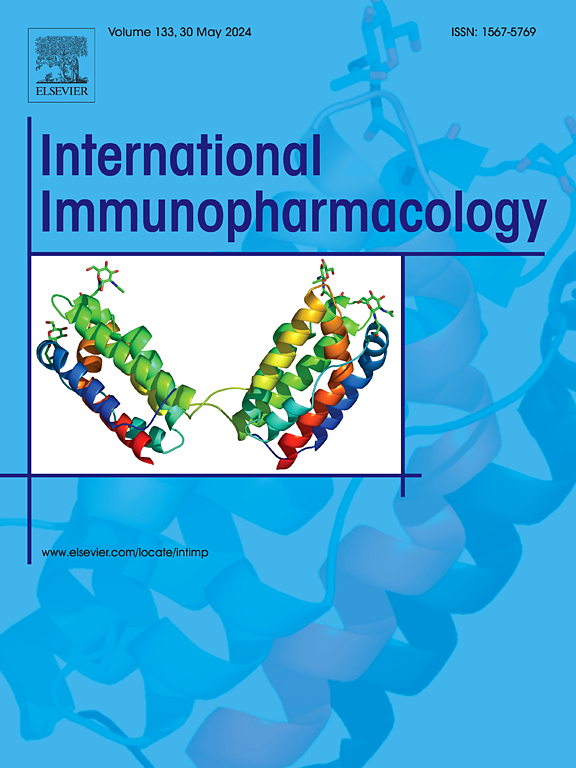rbm15介导的Entpd1/CD39 m6A甲基化调节细胞外ATP水解,减轻心肌缺血再灌注损伤
IF 4.7
2区 医学
Q2 IMMUNOLOGY
引用次数: 0
摘要
心肌缺血再灌注(I/R)损伤是心脏损伤的主要原因,与ATP代谢紊乱和氧化应激有关。虽然m6A RNA甲基化调节各种细胞过程,但其在调节I/R损伤和ATP水解中的作用尚不清楚。在这项研究中,我们证明了体内(大鼠I/R模型)和体外(H/R处理的心肌细胞)模型在I/R损伤期间都表现出增加的m6A修饰水平。在关键的m6A调控因子中,RBM15在缺血心脏组织中显著上调。功能分析显示,RBM15直接调节Entpd1 (CD39)的m6A甲基化,增强其表达和活性。RBM15的过表达促进ATP水解,导致腺苷的产生增加。在I/R模型中,这些分子变化共同减轻了氧化应激,减少了炎症,减少了细胞凋亡,从而改善了心功能,缩小了梗死面积,减少了细胞死亡。这些保护作用被CD39抑制剂(多氧钨酸钠,POM-1)逆转,证实了CD39在这一途径中的关键作用。机制上,RBM15还通过增加磷酸化水平激活AMPK和AKT/ERK/GSK3β信号通路,进一步促进心脏保护。综上所述,rbm15介导的m6A甲基化增强CD39表达,促进细胞外ATP水解并对心肌I/R损伤发挥保护作用,突出了其作为治疗靶点的潜力。本文章由计算机程序翻译,如有差异,请以英文原文为准。

RBM15-mediated m6A methylation of Entpd1/CD39 regulates extracellular ATP hydrolysis and alleviates myocardial ischemia-reperfusion injury
Myocardial ischemia-reperfusion (I/R) injury is a major cause of heart damage, linked to disrupted ATP metabolism and oxidative stress. While m6A RNA methylation regulates various cellular processes, its role in modulating I/R injury and ATP hydrolysis remains unclear. In this study, we demonstrate that both in vivo (rat I/R model) and in vitro (H/R-treated cardiomyocytes) models exhibit increased m6A modification levels during I/R injury. Among key m6A regulators, RBM15 is significantly upregulated in ischemic heart tissue. Functional assays reveal that RBM15 directly modulates the m6A methylation of Entpd1 (CD39), enhancing its expression and activity. Overexpression of RBM15 promotes ATP hydrolysis, resulting in increased adenosine production. These molecular changes collectively mitigated oxidative stress, reduced inflammation, and decreased apoptosis, resulting in improved cardiac function, smaller infarct sizes, and less cell death in the I/R model. These protective effects are reversed by CD39 inhibitor (sodium polyoxotungstate, POM-1), confirming the pivotal role of CD39 in this pathways. Mechanistically, RBM15 also activates the AMPK and AKT/ERK/GSK3β signaling pathway by increasing phosphorylation levels, further contributing to cardioprotection. In summary, RBM15-mediated m6A methylation enhances CD39 expression, facilitating extracellular ATP hydrolysis and exerting protective effects against myocardial I/R injury, highlighting its potential as a therapeutic target.
求助全文
通过发布文献求助,成功后即可免费获取论文全文。
去求助
来源期刊
CiteScore
8.40
自引率
3.60%
发文量
935
审稿时长
53 days
期刊介绍:
International Immunopharmacology is the primary vehicle for the publication of original research papers pertinent to the overlapping areas of immunology, pharmacology, cytokine biology, immunotherapy, immunopathology and immunotoxicology. Review articles that encompass these subjects are also welcome.
The subject material appropriate for submission includes:
• Clinical studies employing immunotherapy of any type including the use of: bacterial and chemical agents; thymic hormones, interferon, lymphokines, etc., in transplantation and diseases such as cancer, immunodeficiency, chronic infection and allergic, inflammatory or autoimmune disorders.
• Studies on the mechanisms of action of these agents for specific parameters of immune competence as well as the overall clinical state.
• Pre-clinical animal studies and in vitro studies on mechanisms of action with immunopotentiators, immunomodulators, immunoadjuvants and other pharmacological agents active on cells participating in immune or allergic responses.
• Pharmacological compounds, microbial products and toxicological agents that affect the lymphoid system, and their mechanisms of action.
• Agents that activate genes or modify transcription and translation within the immune response.
• Substances activated, generated, or released through immunologic or related pathways that are pharmacologically active.
• Production, function and regulation of cytokines and their receptors.
• Classical pharmacological studies on the effects of chemokines and bioactive factors released during immunological reactions.

 求助内容:
求助内容: 应助结果提醒方式:
应助结果提醒方式:


